INTERVIEW Toyota ramps up HD truck hydrogen fuel cell projects
07 August 2023
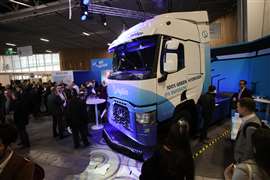 Hyliko hydrogen tractor unveil at the Hyvolution 2023 event in Paris (Photo: Toyota)
Hyliko hydrogen tractor unveil at the Hyvolution 2023 event in Paris (Photo: Toyota)
Eugene Reginald is project lead for Truck and Bus Fuel Cell applications at Toyota Motor Europe in Brussels, Belgium. He states that the role involves managing the process steps which will ultimately see Toyota fuel cell technology applied to a variety of vehicle types.
In North America, heavy-duty vehicle OEMs using Toyota fuel cells include the Paccar brand Kenworth. In Europe, VDL Groep is a Dutch company now working on a Toyota fuel cell-powered truck to support decarbonisation of the Japanese OEM’s logistics operations. The model could be on the road before the end of 2023. French startup Hyliko is also developing a truck using Toyota fuel cells. The plan is to offer these to the market within a combination ‘Hydrogen Fuel & Trucks as a Service’ model (see opening photo).
In this interview, Reginald spoke with Diesel Progress International and New Power Progress editor Julian Buckley about what the Japanese vehicle manufacturing giant has on offer and how it plans to develop and improve its existing hydrogen fuel cell technology.
Julian Buckley (DPI): How long has Toyota been working on fuel cell development?
Eugene Reginald (ER): We’ve been developing fuel cells for passenger cars for more than 30 years. This offers economies of scale and allows us to use the second-generation technology from the Toyota Mirai in truck and bus applications.
Some slight modifications are made to the fuel cell system for heavy-duty applications, but the majority of components are carried over. These are then packaged into two module formats, either a box or flat layout, to suit the vehicle type.
DPI: When two fuel cell modules are used in an application, both are separately delivering electrical energy to the battery pack?
ER: Yes, both modules are working independently; different outputs can be delivered by each module based on onboard monitoring systems. There could be two, three or four modules, depending on the application.
DPI: The difference between fuel cells used in a commercial vehicle and a passenger car comes down to the amount of electricity needed to power the heavier vehicle?
ER: No, that’s not correct. There are modifications to components to suit driving patterns and the road load is different.
DPI: Are there any benefits to using liquid hydrogen over compressed gas to power the fuel cell?
ER: As you might know, the Toyota Gazoo racing vehicles use liquid hydrogen. We currently use compressed hydrogen for the fuel cells in trucks and buses, largely because that’s what’s more widely available.
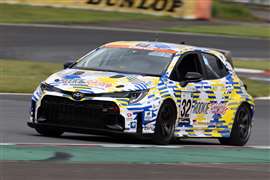 GR Corolla H2 Concept uses liquid hydrogen fuel (Photo: Toyota)
GR Corolla H2 Concept uses liquid hydrogen fuel (Photo: Toyota)
DPI: Did Toyota play a role in designing any of the trucks in preparation for fuel cell installation?
ER: We did provide some support, but only for the fuel cell elements – VDL has vast experience with developing trucks. We provided technical homologation data, plus support with integration of the fuel cell, from a hardware and software standpoint. That included confirmation of the durability of the components and the necessary maintenance plan. Then we completed validation of the package layout, installation in the truck. We also carry out data analysis for the customer.
DPI: Have the trucks received type approval for road use?
ER: They are currently being homologated and registered. That should be completed by the end of this year.
DPI: How has the production of the fuel cells changed, is it still a manual process or has automation been introduced?
ER: In Japan the stack production process is largely automated. Here in Europe we’re producing modules on a much smaller scale so a lot of the processes are still manual. When volumes pick up, we’ll look to add more automation.
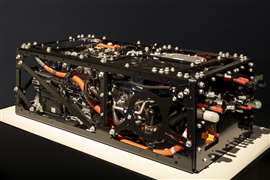 Second-gen Toyota fuel cell module (Photo: Toyota)
Second-gen Toyota fuel cell module (Photo: Toyota)
DPI: Is Toyota actively looking for more customers?
ER: Absolutely! We’re looking at a series of sectors, including marine, rail, power generation. We’ve already got customers in all these areas and this will support increased output.
DPI: Is there any potential for retrofitting an existing diesel truck with a fuel cell powertrain, or is there a preference for ground-up projects?
ER: Toyota is not involved in [retrofitting], we will leave this to conversion companies. But what we have heard from them is that the module setup makes it easy to fit a fuel cell into a space that previously housed an engine or fuel tank.
DPI: Is it possible to achieve the same range as a diesel truck using a fuel cell powertrain?
ER: It is theoretically possible, but it comes down to fuel tank capacity. We have data loggers that gather information about vehicle operation, that could help improve range. But the onboard system display showing driver efficiency is setup by the OEM.
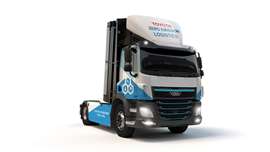 VDL Groep truck featuring Toyota H2 fuel cell powertrain (Photo: Toyota)
VDL Groep truck featuring Toyota H2 fuel cell powertrain (Photo: Toyota)
DPI: Can fuel cells deliver the same operational lifetime as a diesel truck?
ER: At the present time, no. There is a lifetime disadvantage, as with other ZEVs (zero-emission vehicles). We’re looking to close that gap with future technology generations.
DPI: Fuel cells obviously offer great environmental benefits, but they’re very expensive. What can be done to reduce the related costs?
ER: The key to reducing the cost of the fuel cell system is further technical improvements. Of course, economies of scale will also reduce prices. With every new technology there is a cost gap. But as the tech develops, costs will come down. I think we’ll soon see a reduction in costs.
DPI: Can you give us an idea of what’s being done in terms of tech development to reduce costs?
ER: What I can say is that from the first to the second-generation fuel cell modules we saw vast improvements. Power-to-unit volume saw a 54% improvement. Power-to-unit mass, 93%. Just on the stack, the mass was reduced by 21%, the volume by 41%. The trend is going in a good direction.
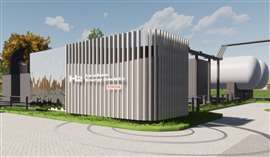 Toyota hydrogen electrolysis system will be installed at Denso plant in Fukushima, Japan (Photo: Toyota)
Toyota hydrogen electrolysis system will be installed at Denso plant in Fukushima, Japan (Photo: Toyota)
DPI: Do you expect the same level of improvement in a third-gen fuel cell stack?
ER: We believe so. An important word in the Toyota vocabulary is ‘kaizen’, or continuous improvement. We see all these kaizens coming together in the third-gen fuel cell stack to deliver sizeable improvements.
DPI: Has there been any success in reducing battery pack size and weight?
ER: It’s not really an across-the-board weight reduction, but one of the things we can do is look at the application and develop a specific solution, using this fuel cell setup with this battery pack and this motor. From that we can say what the power and torque will be. It’s useful for vehicles operating in different terrain types, particularly mountainous regions.
DPI: How does maintenance of a fuel cell compare to a diesel engine?
ER: We see maintenance involving items like the ion exchanger cartridge, air filters, LD coolant. But we don’t see maintenance costs being any higher than those of a diesel truck.
DPI: Is there anything that can be done to maintain vehicle residual values so buyers know what to expect when it comes time to sell on?
ER: Well, we are looking at how to predict what we can do to support the second-hand market. There are tools we can use to monitor the life of the fuel cell and batteries.
DPI: How does the performance of a fuel cell stack decline as it ages? Is it a slow-glide decline, or at some point is there a serious performance drop?
ER: Typically, it’s a gradual deterioration of the fuel cell. It is possible to estimate the percentage of remaining life.
DPI: Have the fuel cells been designed with consideration to end-of-life?
ER: Toyota has always considered end-of-life when developing vehicles and it’s the same for the fuel cells. There are some expensive materials which need to be reclaimed and recycled, but with every component we try to recycle the greatest volume percentage.
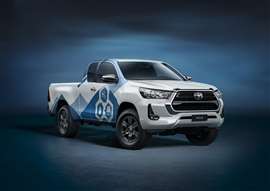 Toyota-led consortium will develop prototype hydrogen fuel cell Hilux pickup in the UK (Photo: Toyota)
Toyota-led consortium will develop prototype hydrogen fuel cell Hilux pickup in the UK (Photo: Toyota)
DPI: Are components for the fuel cells supplied from within the Toyota network, or from third-party providers?
ER: We would first look to have components developed within Toyota and then look to our preferred suppliers.
DPI: What are you looking to do next in terms of fuel cell development?
ER: I think it’s important that we look at size and weight. The goal should be to reduce weight, improve the packaging density, increase power output and durability.
STAY CONNECTED




Receive the information you need when you need it through our world-leading magazines, newsletters and daily briefings.
POWER SOURCING GUIDE
The trusted reference and buyer’s guide for 83 years
The original “desktop search engine,” guiding nearly 10,000 users in more than 90 countries it is the primary reference for specifications and details on all the components that go into engine systems.
Visit Now
CONNECT WITH THE TEAM










